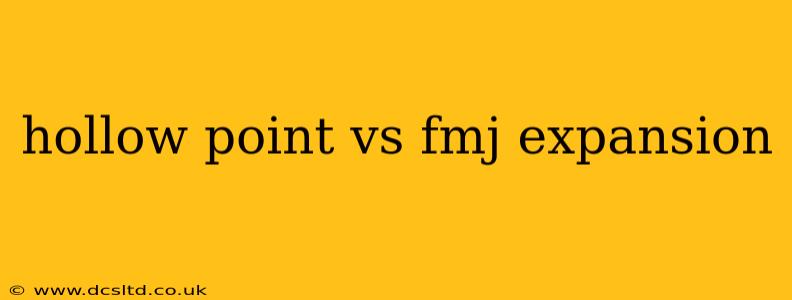Choosing the right ammunition is crucial for various purposes, from self-defense to target practice. Two common bullet types often spark debate: Full Metal Jacket (FMJ) and Hollow Point (HP). Understanding their differences in expansion and terminal ballistics is vital for making informed decisions. This article delves into the specifics, addressing common questions surrounding these popular bullet designs.
What is a Full Metal Jacket (FMJ) Bullet?
A Full Metal Jacket bullet is constructed with a lead core completely encased in a harder metal jacket, typically copper or gilding metal. This jacket protects the lead core from deformation during firing and flight, resulting in a bullet that retains its shape upon impact. This characteristic is why FMJs are often preferred for target practice, as they tend to cause less damage to the target (and the surrounding environment) and are reusable in some cases.
What is a Hollow Point (HP) Bullet?
Unlike FMJs, Hollow Point bullets have a cavity or hollowed-out section in the bullet's tip. This design facilitates expansion upon impact. When a hollow point bullet strikes a target, the cavity allows the bullet to mushroom or deform, increasing its diameter and transferring more energy to the target. This increased energy transfer translates to greater stopping power.
How Does Hollow Point Expansion Work?
The expansion of a hollow point bullet is achieved through the rapid transfer of kinetic energy upon impact. The hollow point design allows the bullet's front to deform significantly, creating a larger wound cavity and increasing energy dissipation within the target. The degree of expansion depends on factors like the bullet's velocity, design, and the material it impacts.
How Does FMJ Penetration Compare to Hollow Point Penetration?
FMJ bullets, due to their construction, generally penetrate deeper than hollow points. The hard metal jacket helps the bullet maintain its shape and velocity, resulting in increased penetration. Conversely, hollow point bullets, while transferring more energy upon impact, typically exhibit less penetration. This is because some of their energy is expended in deformation, which reduces their forward momentum.
What are the Advantages of Hollow Point Bullets?
- Increased Stopping Power: The larger wound cavity created by hollow point expansion leads to greater energy transfer and increased stopping power.
- Reduced Overpenetration: The decreased penetration of hollow points reduces the risk of the bullet passing through the target and potentially harming unintended individuals or objects.
- Greater Wound Cavity: The expansion increases the size of the wound channel, which leads to faster incapacitation of the target.
What are the Advantages of FMJ Bullets?
- Greater Penetration: The unyielding construction allows for greater penetration through barriers and targets.
- Accuracy: Their consistent shape and weight contribute to enhanced accuracy, especially at longer ranges.
- Cost-Effective: FMJ bullets are often less expensive than hollow points, making them ideal for practice shooting.
Which is Better for Self-Defense: Hollow Point or FMJ?
For self-defense, hollow point ammunition is generally preferred due to its greater stopping power and reduced risk of overpenetration. The increased likelihood of quickly incapacitating a threat outweighs the slightly reduced penetration. However, the specific choice should also consider factors like the weapon, distance, and potential environmental obstructions.
Which is Better for Target Practice: Hollow Point or FMJ?
FMJ ammunition is the better choice for target practice. Its lower cost, reduced damage to targets, and greater penetration make it more economical and suitable for practicing accuracy at various ranges. The less destructive nature also promotes longer target life.
Are Hollow Points Legal Everywhere?
The legality of hollow point ammunition varies by jurisdiction. Some areas have restrictions or outright bans on certain types of expanding ammunition. It's crucial to check local laws and regulations before purchasing or possessing hollow point ammunition.
What are the Different Types of Hollow Points?
There are various types of hollow point bullets, each with unique designs and expansion characteristics. These include: jacketed hollow points (JHP), semi-jacketed hollow points (SJHP), and total metal jacket hollow point (TMJHP), among others. Each offers slightly different performance characteristics and levels of expansion.
By understanding the key differences between hollow point and FMJ ammunition, you can make informed decisions based on your specific needs and the intended application. Remember always to adhere to all local and federal laws concerning ammunition ownership and use.
